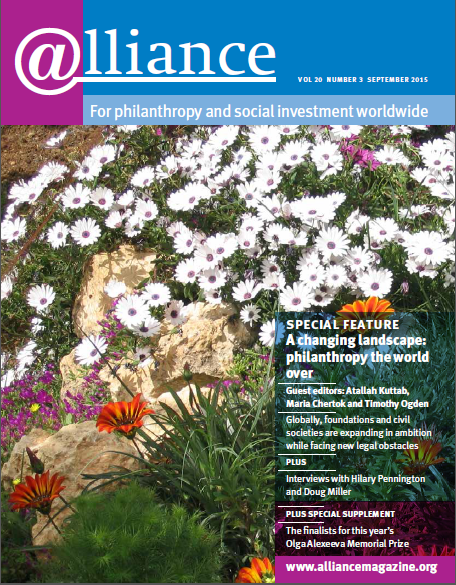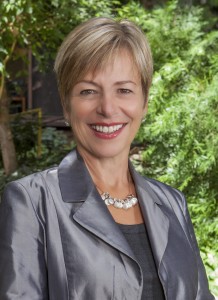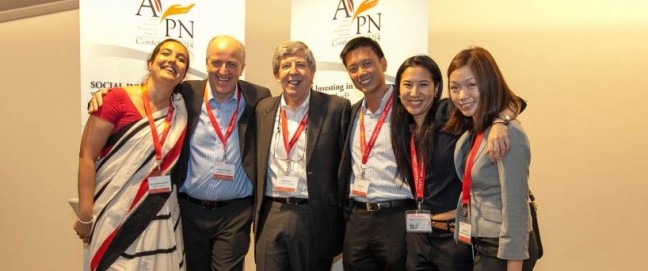There are changes afoot at the Ford Foundation with a new philanthropy programme. Darren Walker, Ford Foundation president, announced a new focus on inequality and a commitment to provide more general operating support, in a blog on 15 June. Hilary Pennington, vice president of the education, creativity and free expression programme at Ford, has been closely involved with these changes. She tells Caroline Hartnell what is behind them.
What are the main features of the Ford Foundation’s new philanthropy programme?
The infrastructure that supports philanthropy has grown much more robust than it was when the foundation started its grantmaking for philanthropic support many, many years ago. Now that we have an opportunity to re-launch our grantmaking in support of philanthropy, the interesting question is ‘what does the field need now that it perhaps didn’t need then?’.
We’ve identified two things we think will be priorities in our future work. One is the issue of transparency, and better information flows between grantmakers and grantseekers. That’s why we’ve made the investment in the Fund for Shared Insight, and why we’re so interested in feedback loops and net promoter scores. Philanthropy works too much like a line. It starts with a foundation that thinks it has a strategy; the money then goes to a grantee; the grantee uses that money to try to influence something that makes the world better for a community or a group of people. It should function much more like a loop.
The second thing is a continued interest in the diversity of leadership in the sector, in philanthropy itself, in philanthropic support organizations, and in the kinds of organizations that we support. We believe that the best solutions are going to come from the people and communities who are closest to the problems that we are trying to solve. How can we get more of those people into positions of influence in the sector, and support their voices so that they have the greatest impact?
Does the Ford Foundation itself collect or use beneficiary feedback?
David Bonbright just did a learning session for our programme officers on constituent feedback loops and a number of them are figuring out ways to try to incorporate that more fully into their work. I would say the programme officers who work on sexual and reproductive rights, for example, have a fair number of ways of getting constituent feedback, but it’s not as uniform across the foundation as we’d like.
‘Philanthropy works too much like a line. It should function much more like a loop.’
What role do you see for community philanthropy in your overall vision of philanthropy?
It’s a form of philanthropy that is highly synergistic with the values that we were just talking about. It moves resources and voice closest to the ground, to the people and the communities who are closest to the problems and the solutions. It’s something that we’re looking at very seriously – we’ve made a couple of small investments in the Global Fund for Community Foundations, for example. At the moment our mandate for the philanthropy grantmaking is to restart in the US, and we’re not doing a lot of global programming. But philanthropy and the growth of the philanthropic sector is a big priority for a number of our regional offices, particularly in parts of the world with growing wealth and a lot of new donors – China, Nigeria, India, South Africa, Brazil – so it was a seed investment for learning that we thought would be important to make.
Are you trying things out in the US first and then planning to expand? Or don’t you know yet?
We don’t know yet. First, we need to see how far our resources go.

The University of San Antonio Abad in Cusco, Peru – a pilot programme studying ways to provide a pathway to higher education for underrepresented minority groups in the Andean region. Credit Sergio Urday/Ford Foundation
Darren Walker has just announced that in future all Ford Foundation money will go towards reducing inequality and that every grant will be looked at through that lens. What does that mean in practice?
Let’s take higher education as an example. Over many years the Ford Foundation has supported knowledge development in higher education, but now we wouldn’t do this just for its own sake. We would be interested in the ways that universities can help to reduce inequality. That might have to do with the kinds of students they enrol, or the kind of research they do, or the role they play in the communities they sit in. Or if you take climate change, we would look at the impact on poor communities and how we could give them more voice in decisions about natural resources.
By virtue of applying that lens, there will be lines of work or grantees that we fund now that we wouldn’t in the future. And new ones that we need to fund that we don’t yet fund.
How will that affect the philanthropy programme?
I think the kinds of things that we’ve been looking at – transparency, stronger feedback, greater diversity of leadership – probably line up well with a focus on equality and social justice. The goal for our philanthropy work is more resources, better deployed, for social justice causes. Under more resources, we’re thinking of ways to entice new donors into social justice issues. ‘Better deployed’ we think has to do with better feedback loops and greater effectiveness.
How do you see your role in regard to stimulating more resources?
We’d be thinking about how we partner with new donors. Most newcomers think of setting up their own organizations, but there’s so much that could be done through both informal and more formal partnerships.
Would the focus on inequality include investment of assets?
As you know, we were one of the first philanthropies to do programme-related investments, and we have now made a big commitment to expand our impact investing.
Does that come out of the endowment or out of grant funds?
Each year we have a current allocation that is for our programme-related investments, or you could say impact investing, that is above and beyond our programme grantmaking.
How does the increased funding for general operating support relate to the inequality focus?
Inequality is really the ‘what’ and ‘why’ of what we will focus on, but there’s also the question of what organizations need ‘more of’ in order to be able to do their work effectively. Inequality issues are endemic and they won’t go away quickly, so we feel that it’s going to be very important to give more resources that help build stronger and more effective partner organizations.
‘Inequality is really the “what” and “why” of what we will focus on, but there’s also the question of what organizations need “more of” in order to be able to do their work effectively.’
Bill Gates once said that ‘becoming like the Ford Foundation would be the worst possible outcome for the Gates Foundation’, and more recently David Callahan of Inside Philanthropy has castigated Ford for its high overheads. What is your response to this?
I think Bill Gates was thinking about the Ford Foundation’s tendency to spread a little money over a lot of things, and at times that has probably been David Callahan’s critique. What we are moving towards now is focusing on fewer things in a deeper way, with deeper support for the grantees that we work with and more flexible support – we believe that’s very important.
But if you think of the ecosystem of philanthropy, we’re more catalytic than strategic. Strategic might mean you have a set of interventions that you identify and stick with – developing better seeds or better vaccines. For the kind of issues that we work on – structural discrimination, for example, or accountable and effective governments – we believe that investing in people and ideas and institutions is really important.
What we hear from our grantees through the Center for Effective Philanthropy’s Grantee Perception Report is that they particularly value the time our programme officers spend helping them to understand trends, see broad perspective on a field, and access greater opportunities and resources. What they want is more time from those programme officers. That kind of value is hard to provide in a completely lean foundation. I’m not being defensive about overhead costs, but I think we need to ask more complex questions about the path to impact.
For more information
http://www.fordfoundation.org
H.Pennington@fordfoundation.org
Ford encourages community involvement in poverty reduction efforts through its support for the Strategic Alliance for Poverty Alleviation (SAPA) in Indonesia.







Comments (0)